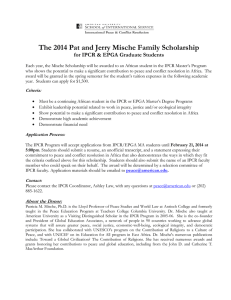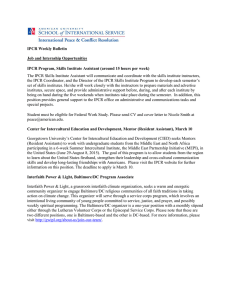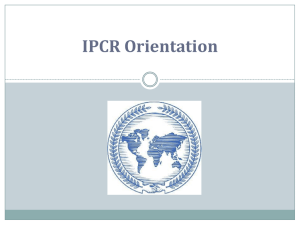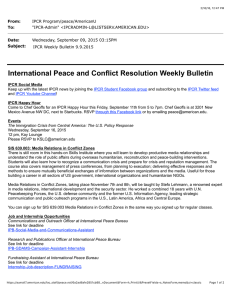The IPCR arrangements: a joined-up approach in crisis response?
advertisement
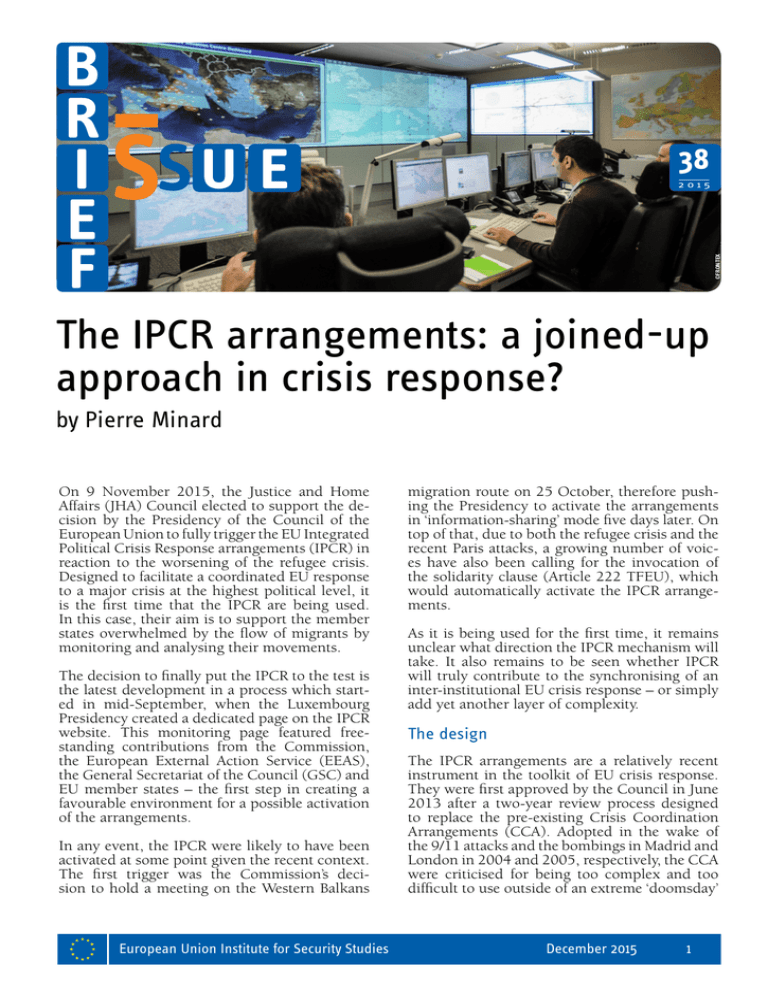
38 ©FRONTEX 2015 The IPCR arrangements: a joined-up approach in crisis response? by Pierre Minard On 9 November 2015, the Justice and Home Affairs (JHA) Council elected to support the decision by the Presidency of the Council of the European Union to fully trigger the EU Integrated Political Crisis Response arrangements (IPCR) in reaction to the worsening of the refugee crisis. Designed to facilitate a coordinated EU response to a major crisis at the highest political level, it is the first time that the IPCR are being used. In this case, their aim is to support the member states overwhelmed by the flow of migrants by monitoring and analysing their movements. The decision to finally put the IPCR to the test is the latest development in a process which started in mid-September, when the Luxembourg Presidency created a dedicated page on the IPCR website. This monitoring page featured freestanding contributions from the Commission, the European External Action Service (EEAS), the General Secretariat of the Council (GSC) and EU member states – the first step in creating a favourable environment for a possible activation of the arrangements. In any event, the IPCR were likely to have been activated at some point given the recent context. The first trigger was the Commission’s decision to hold a meeting on the Western Balkans European Union Institute for Security Studies migration route on 25 October, therefore pushing the Presidency to activate the arrangements in ‘information-sharing’ mode five days later. On top of that, due to both the refugee crisis and the recent Paris attacks, a growing number of voices have also been calling for the invocation of the solidarity clause (Article 222 TFEU), which would automatically activate the IPCR arrangements. As it is being used for the first time, it remains unclear what direction the IPCR mechanism will take. It also remains to be seen whether IPCR will truly contribute to the synchronising of an inter-institutional EU crisis response – or simply add yet another layer of complexity. The design The IPCR arrangements are a relatively recent instrument in the toolkit of EU crisis response. They were first approved by the Council in June 2013 after a two-year review process designed to replace the pre-existing Crisis Coordination Arrangements (CCA). Adopted in the wake of the 9/11 attacks and the bombings in Madrid and London in 2004 and 2005, respectively, the CCA were criticised for being too complex and too difficult to use outside of an extreme ‘doomsday’ December 2015 1 scenario. The IPCR, in contrast, have been designed as a more flexible and tailor-made instrument capable of truly strengthening the political process. Over the past two years, the three successive Presidencies (Italy, Latvia and currently Luxembourg) have been crucial in keeping IPCR arrangements on the agenda, and they committed in their joint programme to ‘pursue the further development of the EU Integrated Political Response arrangements’. Furthermore, the ‘Friends of the Presidency’ group has been in charge of developing the various practical aspects of the instrument from the onset – such as planning detailed standard operating procedures. available and after convening an informal roundtable with all stakeholders, the Presidency can decide to activate the IPCR arrangements in full or in information-sharing mode only – or not at all. It can also choose to do so on its own initiative or upon request by a member state. The aim is to centralise information in order to keep all parties up to date and up to speed. It is worth noting that the Commission, the EEAS and the GSC also have the possibility to activate IPCR in information-sharing mode, provided that the Presidency is consulted beforehand. Once the IPCR have been activated – in full or in info-sharing mode – a crisis page managed by the GSC is opened or replaces the previous monitoring page on the web platform. The continuous flow of information shared by the member The raison d’être of the IPCR arrangements is to states on the web platform serves as the basis for foster the joined-up approach – i.e. the mobilisathe relevant Commission or EEAS services – in tion of all relevant services and bodies amongst the case of the refugees, DG HOME is in the lead institutions and member states and to ensure a – to prepare the Integrated Situational Awareness coordinated set of actions in the EU’s crisis reand Analysis (ISAA) reports. ISAA-related input sponse. This has indeed proved ever more necis gathered on a 24/7 basis by the Emergency essary in recent years Response Coordination due to the increasingly Centre (ERCC) – lo‘The raison d’être of the IPCR cross-cutting nature of cated in DG ECHO – crises. acts as a focal arrangements is to foster the joined-up which point of contact on the That said, this profu- approach – i.e. the mobilisation of all IPCR. sion of institutions relevant services and bodies amongst The Presidency proand bodies with different crisis management institutions and member states and to vides political and cultures, expertise and strategic guidance to competences has been ensure a coordinated set of actions in DG HOME in order met with a degree of to adapt the reports to the EU’s crisis response.’ scepticism. And there the identified needs. is a real and clear risk Because of the constant of having several services in competition with feed of first-hand information from member each other, therefore undermining unity and distates, ISAA reports are key-supporting doculuting available expertise in the EU response to ments for the political decision-making process. crises. It is this tailored approach, addressing the specificities of each crisis, which showcases the flexibility of the instrument. It also helps to provide The procedures the basis on which the Presidency can decide In the event of a crisis, the managing authorito scale up or down, or terminate the IPCR arties of the Commission, the EEAS, the member rangements. states or the Council – the General Secretariat of the Council (GSC) or the Presidency – can creIt is only upon full activation that the decisionate a monitoring page on the IPCR web platform making process is engaged via the presentation to provide regular updates on the evolution of of ISAA reports to the COREPER or the Council. the crisis at hand. The Commission, the EEAS During this last stage, the Presidency is again in and the GSC can use this information to advise the driving seat as it is responsible (as COREPER the Presidency on the whether or not to activate chair) for preparing proposals for action. To supthe IPCR. port this process, the Presidency gathers working level and high-level roundtables to find soThe Presidency has a crucial assessment role to lutions to the specific issues raised by the ISAA play at this stage. After reviewing the information reports. European Union Institute for Security Studies December 2015 2 Workflow of IPCR arrangements Commission/EEAS/ Member states/GSC Crisis MONITORING Presidency ANALYSIS & ADVICE POLITICAL ACTION COREPER or Council POLITICAL AND TECHNICAL ROUNDTABLES Presidency choses participants ASSESSMENT IPCR ACTIVATION Decision taken by… NO Presidency YES, IN FULL Presidency YES, IN INFOSHARING Presidency or Commission/EEAS/GSC (with Presidency consulted) GSC/ERCC with contributions from member states CRISIS PAGE ON IPCR WEB PLATFORM INTEGRATED SITUATIONAL AWARENESS AND ANALYSIS (ISAA) Commission/EEAS Source: EUISS Credits: EUISS On this basis, a set of possible solutions is then in their national policies. This variety has been submitted for discussion either to the COREPER increased by the decision of some members to procedures or – in theThe event of a major crisis that requires introduce temporary controls at their borders, top-level political guidance like the refugee crisis as well as the threats of some to take legal acIn the event of a crisis, the managing authorities of the Commission, the EEAS, the member states or – directly to the Council. tion against the relocation plan proposed by the the Council – the General Secretariat of the Council (GSC) or the Presidency – can create a Commission. monitoring page on the IPCR web platform to provide regular updates on the evolution of the crisis at Thanks to the iterative format of the IPCR, there hand. Commission, the EEAS GSC can use information to advisetothe Presidency is little room forThe an ad hoc workflow. Thisand notthe only Thethis resulting hesitancy engage in a on joint polithe whether or not to activate the IPCR. allows for a streamlined and functional process cymaking process meant that the member states in which each actor is assigned a specific role took a step-by-step approach to crisis response. Presidency has role to playInstead at this stage. After reviewing the information based on The its expertise, butaitcrucial also assessment helps ensure of attempting to fully activate the IPCR available and after convening informal roundtable arrangements, with all stakeholders, the Presidency can decide chose clear political guidance through theanPresidency. the Luxembourg Presidency to activate the IPCR arrangement in full or in information-sharing mode only – or not at all. It canmode for to trigger them in information-sharing also choose to do so on its own initiative or upon request by a member state. The aim is to centralise an initial period of ten days. This allowed memThe implementation information in order to keep all parties up to datebers and to up begin to speed. It is worth noting that the and to consolidating information Commission, the EEAS and the GSC also have the possibility to activate IPCR in information-sharing The option of fully activating the IPCR arrange(re)build trust. ments remains politically sensitive. For exam- beforehand. mode, provided that the Presidency is consulted ple, the stances of member states on how to best It eventually became clear that full activation the IPCR activated in fullasor in info-sharing mode way – a crisis page managed the tackle the Once refugee crisishave varybeen widely, not –least was the best to move forward,bynotably beregards their take the common decicause thisweb would permit the weekly roundtables GSC eagerness is opened or to replaces previous monitoring page on the platform. The continuous flow of sions at EUinformation level and shared the degree restrictiveness held by theserves Presidency to address concerns. The by theofmember states on the web platform as the basis for the relevant Commission or EEAS services – in the case of the refugees, DG HOME is in the lead – to prepare the Integrated Situational Awareness and Analysis (ISAA) reports. ISAA-related input is gathered on a European Union Institute for Security Studies December 2015 3 Presidency can hold political roundtables at ambassadorial level, as well as more technical ones at which experts from member states, the relevant services of the Commission and the EEAS exchange views and ideas. Moreover, the Presidency can invite third parties such as the International Organisation for Migration and the UNHCR to contribute to the debates. In the case of the migration crisis, issues covered included the free movement of people, as well as border and visa issues. In this case, the IPCR arrangements have demonstrated their utility as a flexible but also a politically-attuned instrument. The refugee crisis as a test case The EU has been looking for ways to monitor refugee flows since the outbreak of the crisis, relying on CSDP operations (EUNAVFOR Med), EU agencies (FRONTEX and the European Asylum Support Office), and other partners (hosted at the recent Valletta summit on migration). They now have a unique opportunity to use the IPCR arrangements for the first time. But this poses as much an operational challenge as an institutional one, especially for a tool that has been designed in light of the lessons learnt from the preceding CCA. Because of its structural rigidity, the CCA was never fully activated and was only triggered in information-sharing mode on three occasions: during the 2008 terrorist attacks in Mumbai, in the wake of the 2010 earthquake in Haiti, and after the 2010 eruption of the volcano Eyjafjallajökull in Iceland. While the IPCR mechanism can be more readily triggered, it will not be activated for all major crises. The ongoing conflict in Syria, the political violence in Burundi and the earthquake in Nepal are all examples of crises which featured on the IPCR web platform but did not lead – yet – to the activation of the arrangements, not even in information-sharing mode. These crises are all unfolding outside of the EU and are not considered to have a direct and pressing impact in a similar manner to the refugee crisis. Because the refugee crisis has direct internal consequences for EU member states, it is seen to require intense cooperation, which cannot happen in the absence of a rapid and effective information-sharing system. The migratory crisis may not have been the only one to feature and be closely followed on a monitoring page, but due to its cross-sectoral and cross-border aspects, it is now the testing ground for the IPCR. A joined-up approach in the making? One of the overarching concerns about the EU’s response to crises is the presence of a multitude of institutional actors and bodies. It is often the case that the capacity of the EU to react is hampered by the diversity of voices and a lack of coordination. The IPCR arrangements, too, bring several instruments – and, more importantly, several services – together. Yet, the structured manner in which they engage all stakeholders should lay the foundation for a proper crisisresponse. In fact, most of the inter-institutional tension has been alleviated by the existence of a small crossadministrative ‘community’ at the core of the instrument, composed of experts from the ERCC, the GSC and Commission DGs, who are now used to working and cooperating together at all stages of the arrangements – and even before their activation. The web platform also creates many potential avenues for cooperation, which will become more attractive the more the tool is used. It is exactly this kind of routine cooperation which can contribute to the creation of a concrete crisis response structure among and across EU institutions. Now fully activated, the IPCR arrangements have already gone further than their predecessor, the CCA. The lessons identified at the end of the activation of the IPCR will be of utmost importance. Indeed, this lesson-learning exercise is expected to highlight what added-value the IPCR have brought compared to the CCA and also where the process can be improved. For instance, it is clear that the blurring between internal and external dimensions of crises is now at its peak. As such, it would be useful to think about ways to use the IPCR as a bridging tool to link several related crises together. Looking ahead, the position and the political engagement of the upcoming Dutch and Slovakian Presidencies regarding the use of IPCR will be crucial, in light also of the possible future recourse to the so-called solidarity clause established in Article 222 TFEU. Pierre Minard is an Executive Research ­Assistant at the EUISS. European Union Institute for Security Studies © EU Institute for Security Studies, 2015. | QN-AK-15-038-2A-N | ISBN 978-92-9198-294-3 | ISSN 2315-1110 | doi:0.2815/81043 December 2015 4
